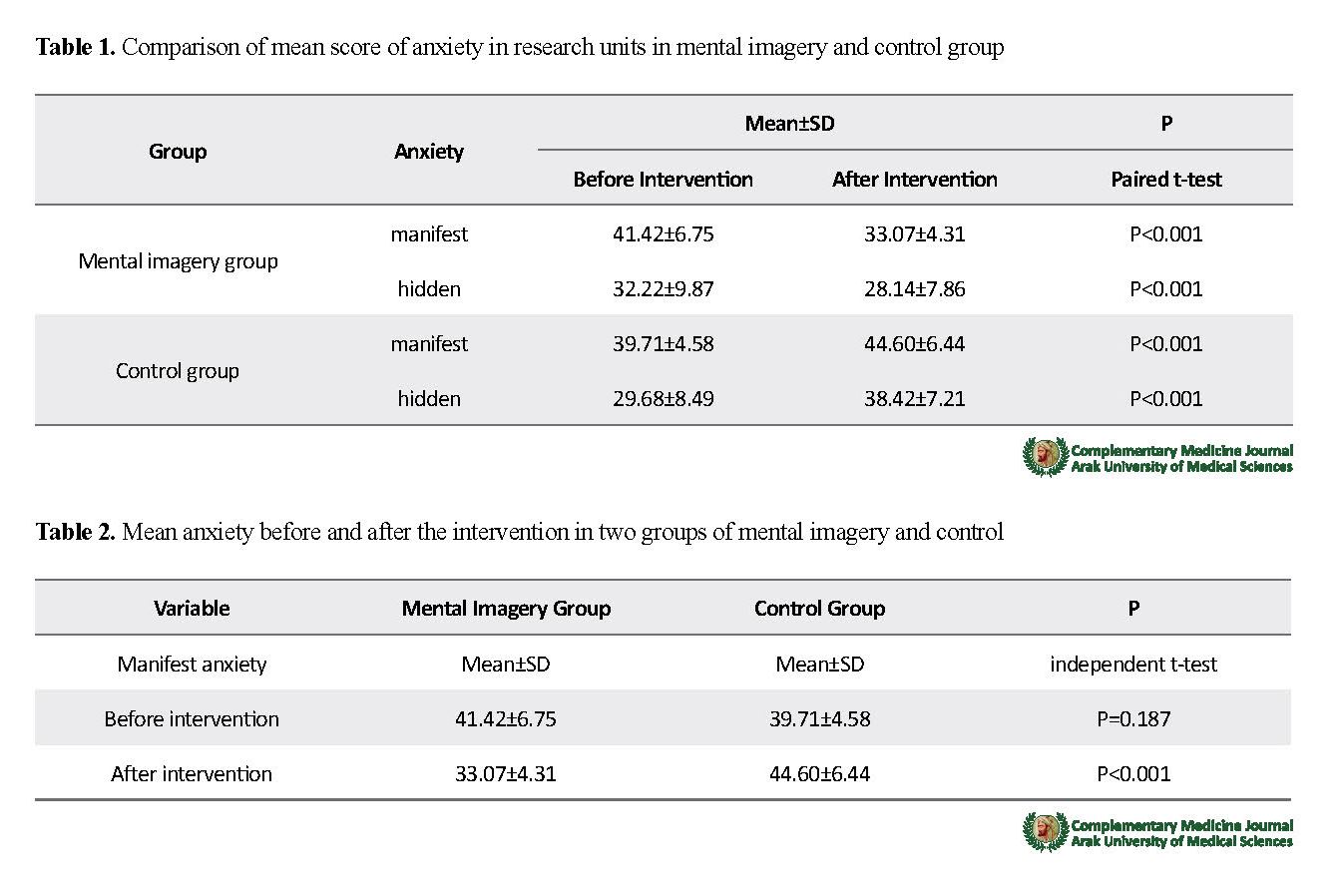Extended Abstract
1. Introduction
No matter how minor the surgery is, it remains an anxiety factor for the patient, so that each patient may consider their surgical operation day as the most threatening day of their lives [2]. Anxiety reduction as a caring approach should be considered for each patient [7]. The treatments currently used to reduce anxiety mainly focus on pharmacological interventions, while some medications cause adverse reactions and delay post-operative waking and discharge [8]. In recent years, the emphasis has been on non-pharmacological methods to reduce anxiety [9]. Non-pharmacological measures due to their non-invasive and inexpensive nature can reduce anxiety, stop or reduce drug use, and increase safety. Mental imagery as part of complementary medicine is a mind-body technique [10]. This technique does not require specialized equipment or extensive training, and the patient is easily trained and readily accepted [11]. Since there are conflicting results from the impact of mental imagery on anxiety, it further highlights the importance of doing research in this regard.
2. Materials and Methods
The present study is a randomized clinical trial that was performed on 56 patients before their hernia surgery. After completing the informed consent form, patients were selected based on accessibility and divided into intervention and control groups using randomized permuted blocks (6-part blocks). The sample size was 30 persons in each group. The demographic questionnaire and Spielberger’s State and Trait Anxiety Inventory (STAI) were used for data collection. One hour before going to the operating room, questionnaires were completed after initial selection of research units. Finally 28 people remained in each group. In the intervention group, in addition to routine care, an audio file containing relaxing music and visualization of beautiful scenery (seashore), along with positive affirmations related to increased health and repetition of calming words such as “God”, “love” and “beauty” aired through headphones for 18 minutes an hour before surgery.
The control group received only routine care and anxiety was again measured after 18 minutes. At the end of the study, the Spielberger questionnaire was completed in both groups. Data were analyzed by SPSS V. 20 and statistical tests used were Mann-Whitney, chi-square, paired t-test, independent t-test and Analysis of Variance (ANOVA).
3. Results
The mean age of the subjects was 30.8±17.28 in the intervention group and 32.9±14.18 in the control group. Findings of the study showed that there was no statistically significant difference between the two groups in terms of age, sex, marital status and educational level.
Mean pre and post-intervention anxiety in intervention group was 41.42±6.75 and 32.22±9.87 respectively, which decreased to 33.07±4.31 and 28.14±7.86 after intervention, respectively. In the control group, they were 39.71±4.58 and 29.68±8.49, which at the end of the study increased to 44.60±6.44 and 38.42±7.21, respectively. This difference was statistically significant (P<0.001) (Table 1).

Before intervention, there was no significant difference between the two groups regarding the level of manifest anxiety (P=0.187). However, there was a significant difference after intervention (P=0.001) (Table 2).
4. Discussion
The findings of the present study showed that preoperative mental imagery reduces anxiety in the intervention group compared to the control group.
Results of the study by Gonzales et al showed that this method was effective in reducing preoperative anxiety [21]; but in their study of the control group - unlike the present study - there was no significant difference between baseline and preoperative anxiety, which is an expected phenomenon with respect to approaching the time of surgery.
In a review study, Hadjibalassi et al. reported that mental imagery was effective in improving the physical and mental health outcomes of patients in the intensive care unit [22]. In the study of Beyza’i et al., mental imagery has been shown to reduce anxiety, depression, and stability of vital symptoms in patients undergoing hemodialysis, which is consistent with the results of the present study [23].
In contradiction with the results of the current study, Thomas et al. reported the ineffectiveness of mental imagery in reducing postoperative anxiety [24]. Discrepancies between the results of these two studies can be attributed to reasons such as the research method; also the Thomas study had only post-test. The number of women in the intervention group was higher than the control group, so that this difference was significant. Also, the selection of participants in the intervention group was non-random. The results of the study by Urech et al. also showed no significant difference between mental imagery compared to muscle relaxation on reducing anxiety in pregnant women [25]. This difference may be due to the sample size (n=13) and the duration of the intervention (10 minutes). In general, these findings suggest a more parasympathetic activity that changes the physiological responses and subsequently, patients feel more relaxed and less anxious [21].
Mental imaging can be used as an easy, inexpensive and non-invasive way to reduce patients’ anxiety before surgery.
Ethical Considerations
Compliance with ethical guidelines
This article was extracted from a research project approved by Sabzevar University of Medical Sciences with code of ethics MEDSAB.REC.92.1. It was also registered at the Iranian Clinical Trial Registration Center with the code IRCT2013122315905N1.
Funding
Sabzevar University of Medical Sciences financialy supported this study.
Authors' contributions
Article designing, sampling and compilation: Narjes Heshmatifar, Mahboubeh Mohebbi and Fatemeh Borzouei; Statistical issues: Mohammad Hassan Rakhshani.
Conflicts of interest
There is no conflict of interest in this study.
Acknowledgements
We are grateful to the research deputy of Sabzevar University of Medical Sciences, management of Shahid Beheshti Hospital, the general surgery staff.
